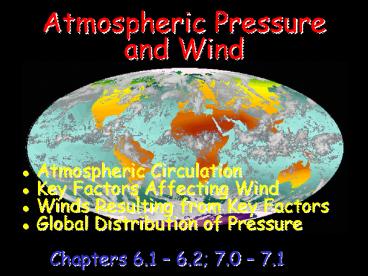Atmospheric Pressure and Wind - PowerPoint PPT Presentation
1 / 27
Title:
Atmospheric Pressure and Wind
Description:
... gradient force would cause air to blow from an area of high pressure toward ... Results in geostrophic wind, which blows parallel to the isobars ... – PowerPoint PPT presentation
Number of Views:168
Avg rating:3.0/5.0
Title: Atmospheric Pressure and Wind
1
Atmospheric Pressureand Wind
- Atmospheric Circulation
- Key Factors Affecting Wind
- Winds Resulting from Key Factors
- Global Distribution of Pressure
- Chapters 6.1 6.2 7.0 7.1
2
Atmospheric Circulation
____________________________
- The general circulation serves to redistribute
latitudinal imbalances of energy and moisture,
and provides our winds
3
Atmospheric Circulation
____________________________
- Winds are designated according to the compass
point from which the wind comes - An east wind comes from the east, but the air is
moving westward
Not in Book
4
Key Factors Affecting Wind
____________________________
- Pressure Gradient Force
- Coriolis Effect
- Friction
- These factors affect the wind speed and direction
5
Pressure Gradient Force
____________________________
- A force that arises from spatial variation in
pressure. Acting alone, the pressure gradient
force would cause air to blow from an area of
high pressure toward an area of low pressure - Initiates air flow
6
Pressure Gradient Force
____________________________
Not in Book
7
Pressure Gradient Force
____________________________
Not in Book
8
Coriolis Effect
____________________________
- The deflective effect of the Earths rotation on
all free-moving objects, including the atmosphere
and oceans - Deflection is to the right in the Northern
Hemisphere - Deflection is to the left in the Southern
Hemisphere
9
Coriolis Effecton a southward moving object
____________________________
Relates to Figure 6.4
10
Coriolis Effecton an eastward moving object
____________________________
Relates to Figure 6.4
11
Coriolis Effecton an eastward moving object
____________________________
Relates to Figure 6.4
12
Coriolis Effect
____________________________
- This effect is always directed at right angles to
the direction of airflow - Affects only wind direction, not speed
- Is affected by wind speed (the stronger the wind,
the greater the deflection) - Is strongest at the poles, and weakens equatorward
13
Coriolis Effect
____________________________
Not in Book
14
Friction
____________________________
- A force that acts to slow wind, but does not
change its direction on its own - Friction changes wind direction by affecting the
Coriolis effect (Coriolis effect is a function of
wind speed)
15
Winds Resulting from Key Factors
____________________________
- Pressure Gradient Force (PGF) Alone
- PGF and Coriolis Effect (upper air)
- PGF, Coriolis Effect, and Friction (surface)
- Surface and Upper-Air Pressure Maps
16
Pressure Gradient Force Alone
____________________________
- High pressure at the surface is associated with
air subsiding from aloft and diverging at the
surface - Low pressure at the surface is associated with
air converging at the surface and ascending
17
____________________________
Not in Book
18
PGF and Coriolis Effect (Upper Air)
____________________________
- There is an equilibrium between the pressure
gradient force and the coriolis effect - Results in geostrophic wind, which blows parallel
to the isobars
19
PGF and Coriolis Effect (Upper Air)
____________________________
Figure 6.6
20
PGF, Coriolis, and Friction (Surface)
____________________________
- Friction slows down the wind speed, which reduces
the coriolis effect - With a reduced coriolis effect, the wind crosses
the isobars at an angle
21
PGF, Coriolis, and Friction (Surface)
____________________________
Figure 6.8
22
Resultant Winds
____________________________
- Surface winds
- Upper-air winds
23
Surface Winds
____________________________
Not in Book
24
Surface Winds
____________________________
Not in Book
25
Upper-Air Winds
____________________________
26
Atmospheric Circulation
____________________________
- With an understanding of the factors influencing
wind speed and direction, we can now look at the
general circulation of the atmosphere
27
(No Transcript)































